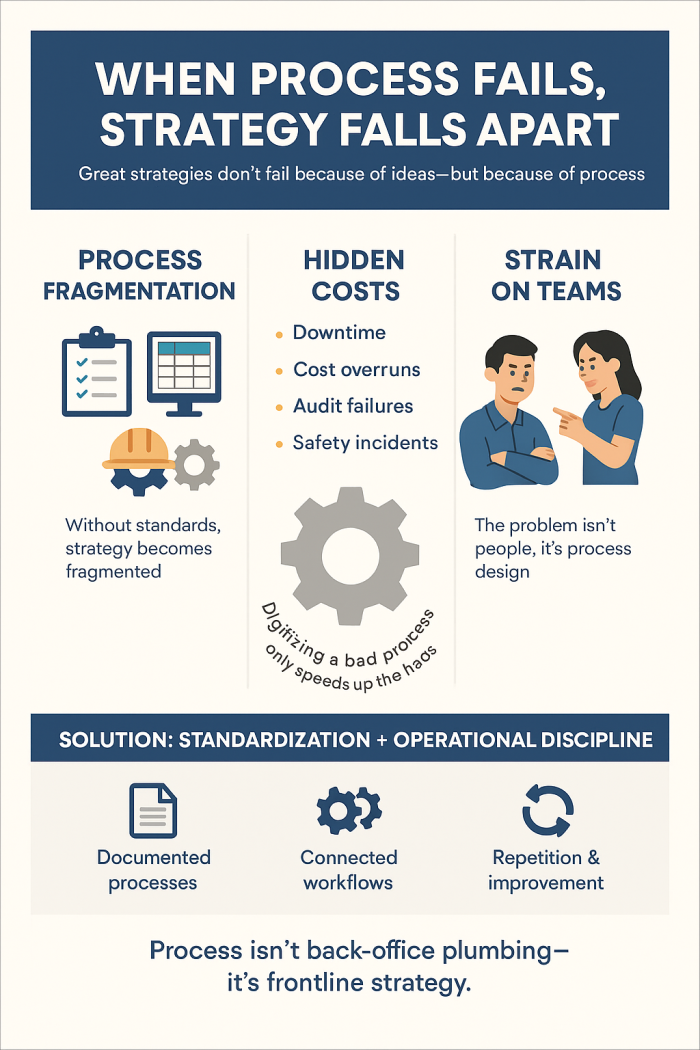Great strategies don’t fail because of bad ideas—they fail because of broken execution. In mining, oil & gas, and heavy equipment operations, execution is process. And when that process is inconsistent, undocumented, or overly manual, even the best strategic intent collapses into daily chaos.
Strategy Doesn’t Break in the Boardroom—It Breaks in the Field
Leadership may agree on cost discipline, uptime targets, or ESG compliance. But what happens when one site runs procurement approvals manually, another relies on tribal knowledge for job costing, and a third tracks maintenance on paper? The strategy exists—but it’s fragmented across processes that don’t talk to each other.
In these industries, execution happens in harsh, high-risk environments. Without consistent workflows, predictable handoffs, and standardized metrics, even routine operations turn into risk events. Strategic alignment fades, replaced by local workarounds and invisible inefficiencies.
The Hidden Cost of Process Fragmentation
The symptoms are everywhere:
- Unplanned downtime due to missed preventive maintenance
- Budget overruns because of inaccurate cost forecasting
- Audit failures from inconsistent financial tracking
- Safety incidents from unclear task execution
What’s more dangerous? These process failures are rarely visible to the board—until they become financial or reputational problems.
People Aren’t the Problem—Process Is
It's easy to blame frontline teams for poor execution. But in most cases, the problem isn’t discipline—it’s design. Handoffs fail because no one owns them. Thresholds aren’t enforced because they’re not defined. Teams improvise because the system doesn’t support their needs.
When process is broken, performance becomes personal. Friction builds. Silos grow. And finger-pointing replaces collaboration.

Customer Job (from Value Proposition Canvas)
“Plan and schedule mining operations efficiently; control operational and financial costs”
Related Pains
- Manual processes and disconnected systems increase risk
- Fragmented workflows hinder cost control and asset management
- Tribal knowledge replaces structured planning and documentation
Poor Process Can’t Be Digitized—Only Amplified
Some organizations think they can fix process problems by buying tools. But digitizing a bad process doesn’t improve it—it scales its dysfunction. A job costing app won’t solve inconsistent definitions. A dashboard won’t align processes that were never standardized.
Before automation, you need architecture. Before reporting, you need repeatability. If the process isn’t consistent, the outcome won’t be either—no matter how modern the system.
When Standardization Feels Like a Threat, Look Closer
Many leaders fear standardization will slow down innovation. But the opposite is true. Standard processes enable strategic agility—by making excellence repeatable, trackable, and improvable.
In volatile environments, what you need isn’t local genius—it’s enterprise clarity. That starts with well-documented, cross-functional processes that scale beyond the heroics of individuals.
Conclusion: Discipline Is the Strategy You Can Control
You can’t control commodity prices or labor shortages. But you can control how work is planned, executed, and improved. That makes operational discipline your most reliable competitive edge.
In today’s industrial landscape, process isn’t back-office plumbing—it’s front-line strategy. And companies that fail to recognize this will continue to lose value in ways they can’t see—until it’s too late.
